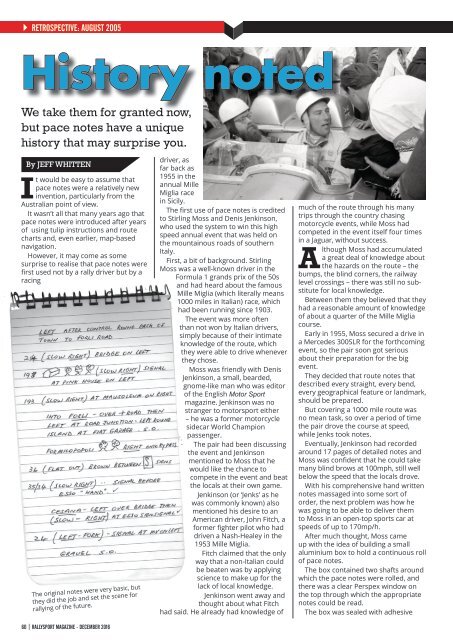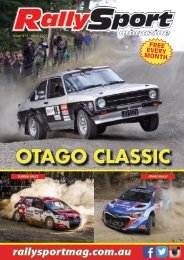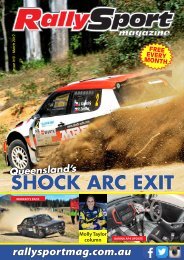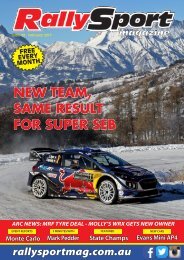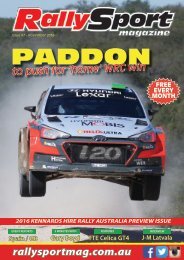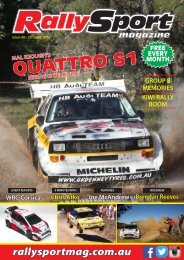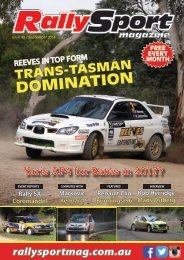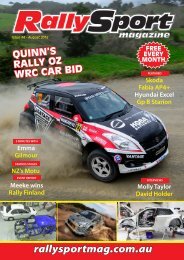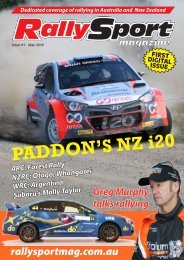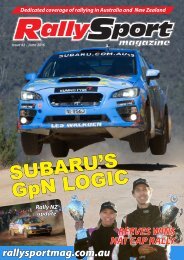RallySport Magazine December 2016
RallySport Magazine December 2016, featuring: Full 2016 Rally Australia coverage Latest news: * New AP4 Mini Cooper for Eli Evans * Subaru back for more in 2017 ARC * Quantock wins Paddon scholarship * Mixed news for top ARC crews * Ogier, Tanak confirmed at M-Sport Feature stories: * Frank Kelly - the mad Irish Escort star, Part 2 * We drive a one-make series Ford Fiesta * Remembering the PNG Safari * Travelling man: Hayden Paddon * The history of pace notes explained * Hayden Paddon column * The Inside Line with Martin Holmes Interviews: * 5 minutes with Molly Taylor * Hyundai’s Michel Nanden Event reports: * Kennards Hire Rally Australia * Rally of India APRC * Classic Adelaide Rally * Begonia Rally * Silver Fern Rally * NSW Rally Championship * Southern Cross Rally
RallySport Magazine December 2016, featuring:
Full 2016 Rally Australia coverage
Latest news:
* New AP4 Mini Cooper for Eli Evans
* Subaru back for more in 2017 ARC
* Quantock wins Paddon scholarship
* Mixed news for top ARC crews
* Ogier, Tanak confirmed at M-Sport
Feature stories:
* Frank Kelly - the mad Irish Escort star, Part 2
* We drive a one-make series Ford Fiesta
* Remembering the PNG Safari
* Travelling man: Hayden Paddon
* The history of pace notes explained
* Hayden Paddon column
* The Inside Line with Martin Holmes
Interviews:
* 5 minutes with Molly Taylor
* Hyundai’s Michel Nanden
Event reports:
* Kennards Hire Rally Australia
* Rally of India APRC
* Classic Adelaide Rally
* Begonia Rally
* Silver Fern Rally
* NSW Rally Championship
* Southern Cross Rally
Create successful ePaper yourself
Turn your PDF publications into a flip-book with our unique Google optimized e-Paper software.
RETROSPECTIVE: AUGUST 2005<br />
History noted<br />
We take them for granted now,<br />
but pace notes have a unique<br />
history that may surprise you.<br />
By JEFF WHITTEN<br />
It would be easy to assume that<br />
pace notes were a relatively new<br />
invention, particularly from the<br />
Australian point of view.<br />
It wasn’t all that many years ago that<br />
pace notes were introduced after years<br />
of using tulip instructions and route<br />
charts and, even earlier, map-based<br />
navigation.<br />
However, it may come as some<br />
surprise to realise that pace notes were<br />
first used not by a rally driver but by a<br />
racing<br />
The ‘Supreme Rat Traps’<br />
Vanguard stuck in a bog in<br />
the 1955 Redex Trial.<br />
The original notes were very basic, but<br />
they did the job and set the scene for<br />
rallying of the future.<br />
60 | RALLYSPORT MAGAZINE - DECEMBER <strong>2016</strong><br />
driver, as<br />
far back as<br />
1955 in the<br />
annual Mille<br />
Miglia race<br />
in Sicily.<br />
The first use of pace notes is credited<br />
to Stirling Moss and Denis Jenkinson,<br />
who used the system to win this high<br />
speed annual event that was held on<br />
the mountainous roads of southern<br />
Italy.<br />
First, a bit of background. Stirling<br />
Moss was a well-known driver in the<br />
Formula 1 grands prix of the 50s<br />
and had heard about the famous<br />
Mille Miglia (which literally means<br />
1000 miles in Italian) race, which<br />
had been running since 1903.<br />
The event was more often<br />
than not won by Italian drivers,<br />
simply because of their intimate<br />
knowledge of the route, which<br />
they were able to drive whenever<br />
they chose.<br />
Moss was friendly with Denis<br />
Jenkinson, a small, bearded,<br />
gnome-like man who was editor<br />
of the English Motor Sport<br />
magazine. Jenkinson was no<br />
stranger to motorsport either<br />
– he was a former motorcycle<br />
sidecar World Champion<br />
passenger.<br />
The pair had been discussing<br />
the event and Jenkinson<br />
mentioned to Moss that he<br />
would like the chance to<br />
compete in the event and beat<br />
the locals at their own game.<br />
Jenkinson (or ‘Jenks’ as he<br />
was commonly known) also<br />
mentioned his desire to an<br />
American driver, John Fitch, a<br />
former fighter pilot who had<br />
driven a Nash-Healey in the<br />
1953 Mille Miglia.<br />
Fitch claimed that the only<br />
way that a non-Italian could<br />
be beaten was by applying<br />
science to make up for the<br />
lack of local knowledge.<br />
Jenkinson went away and<br />
thought about what Fitch<br />
had said. He already had knowledge of<br />
much of the route through his many<br />
trips through the country chasing<br />
motorcycle events, while Moss had<br />
competed in the event itself four times<br />
in a Jaguar, without success.<br />
Although Moss had accumulated<br />
a great deal of knowledge about<br />
the hazards on the route – the<br />
bumps, the blind corners, the railway<br />
level crossings – there was still no substitute<br />
for local knowledge.<br />
Between them they believed that they<br />
had a reasonable amount of knowledge<br />
of about a quarter of the Mille Miglia<br />
course.<br />
Early in 1955, Moss secured a drive in<br />
a Mercedes 300SLR for the forthcoming<br />
event, so the pair soon got serious<br />
about their preparation for the big<br />
event.<br />
They decided that route notes that<br />
described every straight, every bend,<br />
every geographical feature or landmark,<br />
should be prepared.<br />
But covering a 1000 mile route was<br />
no mean task, so over a period of time<br />
the pair drove the course at speed,<br />
while Jenks took notes.<br />
Eventually, Jenkinson had recorded<br />
around 17 pages of detailed notes and<br />
Moss was confident that he could take<br />
many blind brows at 100mph, still well<br />
below the speed that the locals drove.<br />
With his comprehensive hand written<br />
notes massaged into some sort of<br />
order, the next problem was how he<br />
was going to be able to deliver them<br />
to Moss in an open-top sports car at<br />
speeds of up to 170mp/h.<br />
After much thought, Moss came<br />
up with the idea of building a small<br />
aluminium box to hold a continuous roll<br />
of pace notes.<br />
The box contained two shafts around<br />
which the pace notes were rolled, and<br />
there was a clear Perspex window on<br />
the top through which the appropriate<br />
notes could be read.<br />
The box was sealed with adhesive


